#daily monitor covid 19
Explore tagged Tumblr posts
Text
Also preserved in our archive (Updates daily!)
A bit California specific in some cases, but generally good advice to follow: You want your vaccination to lead the wave by a month or two to get the best protection from your vaccination.
By Carly Severn
If you haven’t yet sought out your updated COVID-19 vaccine — or your flu shot — now might be a good time.
That’s because, after a lengthy COVID-19 surge this summer that lasted twice as long as 2023’s summer swell, the Bay Area is now about to enter the winter respiratory virus season.
In August, the updated 2024 COVID-19 vaccine was made available to everyone age 6 months and over, with shots from manufacturers Pfizer, Moderna and most recently, Novavax. These COVID-19 vaccines are now provided as annual fall vaccines, alongside the yearly flu shot, updated to target the latest strains and timed in order to offer maximum protection against the predicted winter surge of these viruses.
All of which means if you haven’t gotten either your COVID-19 or flu shot yet at this stage in the fall, seeking them out in the next few weeks is a good idea. Keep reading for what you need to know about fall vaccines, including the best time to get them, what to do if you got COVID-19 this summer and more.
When is the best time to get my COVID and flu shot? The recommendations medical professionals make about when to get a COVID-19 or flu shot are based on:
The fact that it takes about two weeks after you get vaccinated for antibodies to develop and provide protection against the virus When levels of the virus are predicted to rise that year Getting your COVID shot
Last year, the Bay Area’s fall and winter COVID-19 surge began in late October, according to Stanford University’s WastewaterSCAN team, which monitors levels of the virus in local sewage. And when it comes to the timing of your COVID-19 shot, you want to aim for what UCSF infectious disease expert Dr. Peter Chin-Hong called “the Goldilocks moment.”
“You don’t want to get it too soon because your antibodies might wane just when you need it the most,” Chin-Hong said. “And you don’t want to get it too late because you want to prevent infection. So generally, by Halloween or mid to late October is when most people say the right time is.”
The reason for this, explained Chin-Hong, is to ensure you get your full immunity ahead of the busy holiday season, from trick-or-treating at Halloween to holiday travel, Thanksgiving and beyond.
With your vaccine, “you not only get protection against serious disease, hospitalization and death, but you get a little bit of a buffer against infection itself,” Chin-Hong said. “So that if you want to have peace of mind while doing all of these things, it’s probably a good idea to peak your antibodies just when people are getting together again.”
Getting your flu shot
The Centers for Disease Control and Prevention estimates that last year’s flu season caused between 17,000 and 100,000 deaths and up to 900,000 hospitalizations. Typically, flu season starts in November and peaks around January or February, Chin-Hong said.
The CDC recommends that everyone 6 months and older get an annual flu vaccine “ideally by the end of October.” Chin-Hong told KQED that his “optimal sweet point” for getting this shot is “sometime before Halloween” — but that if you see flu cases start to rise earlier, you should hustle to seek out your flu shot even sooner.
Can I get my COVID and my flu shot at the same time? Yes — it’s totally fine and safe to get your flu shot at the same time as your new COVID-19 vaccine, and you’ll find many pharmacies offer appointments where you can get multiple vaccines at the same time.
A caveat: if you’re trying to schedule vaccinations for a child, the CDC advised in 2023 that you first talk to your pediatrician about the best schedule for the COVID-19 and flu vaccines (and now the RSV — respiratory syncytial virus — preventive treatment, too).
I got COVID over the summer. Do I still need a COVID shot? Yes, Chin-Hong said — although make sure you’re not getting a shot too soon after having COVID-19.
That’s because “after getting infected with COVID, in general, you have a force field for around three months,” Chin-Hong said, meaning your infection will give you a good level of immunity against getting COVID-19 again during that period.
That said, this immunity will wane, Chin-Hong said, so having “a little bit of a buffer” is something to consider. This means getting your COVID-19 shot even after two months “won’t be a bad idea if it coincides with the time when we expect COVID to come back.”
Where can I get my COVID and flu shot? For full information on how to find an updated 2024 COVID-19 shot, read our guide. If you have health insurance, the cost of your COVID-19 vaccine should be fully covered.
To learn more about where to find a flu shot with or without insurance, read our 2023 guide to locations offering flu vaccination around the Bay Area.
Remember that many locations — including pharmacies — will offer appointments where you can get both vaccines at the same time.
What about RSV? Should I get a vaccine for that? The CDC said that while RSV “does not usually cause severe illness in healthy adults and children,” older adults and infants younger than six months of age are especially at risk of becoming “very sick and may need to be hospitalized.”
The vaccine against RSV is accordingly recommended by the CDC for infants, young children and adults ages 60 and older, as well as for pregnant people.
The virus spreads in the fall and winter like other respiratory viruses and “usually peaks in December and January,” according to the agency, which recommends that vaccination against RSV “will have the most benefit if administered in late summer or early fall [August through October], just before the RSV season.”
Speak to your health care provider about getting the RSV vaccine, when might be the best time for you and whether to get it alongside other vaccines. And as ever, if you’re trying to schedule your kid’s vaccinations, the CDC advises that you first talk to your pediatrician about the best schedule for the COVID-19, flu and RSV vaccines.
#mask up#covid#pandemic#public health#wear a mask#covid 19#wear a respirator#still coviding#coronavirus#sars cov 2#vaccination#get vaccinated#vaccines#covid19#covid vaccine#influenza#flu
60 notes
·
View notes
Text
Job Opportunity in (edit western mass)
edit: hi! i am in western mass now, hoping to settle in northampton/greenfield. for full disclosure i am no longer housed because i was only able to maintain my housing via reliance on my abusive father and that ceased to be an option. going to rewrite this post when i can. iso someone comfortable working with someone living out of their car/shelters.
Hello! I'm a multiply disabled medically complex wheelchair user in greater boston who relies on caregivers and i am hiring! No experience necessary, just be resourceful, patient, covid cautious, dependable, and an enthusiastic learner. Especially looking for other fat people! Hoping for someone who drives but I am accessible via the T.
Turning to tumblr as a bit of a hail mary because i am having a really hard time finding someone who can do the job, show up, and also be normal to me as a fat disabled queer through local channels, and i have one worker now who comes as often as they can, but ive been without adequate support for a while. i would appreciate anyone and everyone who reblogs, to possibly get this in the eyes of someone who might be a good fit! welcoming advice as well!
I have the sweetest esa cat
Pay is 19$ an hour funded by masshealth, i have 30-35 hours available and you can work as many or as few of those as you want
Im still very much trying to figure out life with my disability and how to function and organize and communicate my needs and navigating what I'm emotionally able to accept help with, but in general I need help with housework, cooking, managing my medical care, pushing me in my manual wheelchair, sometimes help using a slide board, and I'm still trying to figure out what things look like on a daily basis. going places with or for me. helping me get in the car, helping me pack a backpack if i need to go somewhere. getting mail, helping clean and pick things up off the floor, organizing medical appointments, making phone calls, unpacking medical equipment. emptying a pee jar. Helping me manage/charge medical equipment. I have a hard time lifting my arms a lot because of really bad neck issues, and i have really limited stamina. Putting drinks in smaller bottles, taking packaging off things. I also kind of need help with dressing and bathing sometimes but I have a really hard time coping with that and so like. That happens when it happens and is what it is. I have some systems for washing my hair without actually getting in the shower. I have variable conditions so things might not be the same all the time, on a good day I might be able to sit up for a while and do tasks, on a bad day it's very hard to bring a drink to my lips.
There's no physically lifting my entire body, but I do need someone who can lift the 50lb largest piece of one my wheelchairs and standard everyday heavy stuff like groceries or boxes of protein shakes. And sometimes my limbs. There's also likely things like reaching and stooping, alas, I drop a lot of things on the floor. I have a lot of allergies and some tasks are more complicated than they otherwise might be, and Im really hoping to find someone who can pay attention to detail and is comfortable working through things slowly.
i have a lot of allergies so memory and attention to detail are important, as is a willingness to wash hands frequently. i have a disorder called mast cell activation syndrome and frankly the precautions i need to take feel absurd
covid precautions:
Masks required! I'm hoping to find someone who also takes other precautions.I also need someone to be careful about monitoring yourself and not coming in if you are sick with *anything* because I *will* get it and it *will* be a multiple week ordeal where I likely experience dangerous symptoms. must be able to test weekly and mask with a k/n95 while around me. ideally be someone who lives low risk (masks everywhere, doesnt attend crowded events / spaces, etc). cannot be someone with a high risk lifestyle (has kids in primary school, unmasked in food service areas regularly, etc) we can talk about my precautions too, right now i havent left my house in weeks, i have two way masking with my current pca, and occasionally an unmasked delivery person will come into my apartment though id like to work on solutions to this. i need to like. revamp my precautions. but i dont go anywhere without a mask, i only have unmasked contact with another person if someone comes into my apartment and i cant get to my mask, i am eating while my pca is here and they are masked, or when my also homebound and careful partner is visiting. if someone was working for me more than 25 hours a week and lived a very low risk life i might be open to having a bubble with them during non surge times with precautions like air filters?
i really try to create a calm and positive work environment, though i have complex and real needs and i've been struggling to survive for a long time and i am very overwhelmed. i care deeply about a humanizing workplace, and i am looking for someone who will care enough about my needs as a human being to take the job seriously even though i am as flexible as possible.
About me, in case that helps?
Fat genderfluid dyke. I'm on my third medical leave from college (like a champ!) but I study medical anthropology, disability studies, and linguistics. I don't get out much or do a lot right now because of my illness but i like fiber arts, music, I don't do tons because I spend most of my time in bed but im really passionate about mutual aid, it's been a a minute but I've been wanting to get back into d&d, I think the magicians is the greatest work of television ever written, and I've been trained as a clown and want to try stand up (well, sit down) comedy at some point. I'm a bit neurotic but very self aware. trying to sort out anticonsumerism in the context of my disability. i value creativity, resourcefulness, autonomy, and consent.
(if this went like really well, i am also potentially looking to apply for housing assistance with accommodation for a room for a live in aid, but probably in western mass. idk)
Gwen :) he/they
Message for details
112 notes
·
View notes
Text
Brazil suffocates beneath smoke from record fires
The country has turned into a vast inferno, with at least 11.3 million hectares devastated this year, almost 10 times the size of the Paris region. More than 60% of Brazil is covered by smoke, which is also spreading to neighboring countries.

They were thought to have vanished, blown away or shoved to the back of drawers. Now, they're making a comeback, appearing in public spaces and indoors alike. Surgical masks used during the Covid-19 pandemic are making a return to daily life in Brazil. This time, they're not being used to protect against a virus but against the pollution caused by the forest fires ravaging the country.
Over 60% of the territory, or 5 million square kilometers, is now covered by smoke. A thick, grayish slick, visible from space and felt acutely on the ground. In the last few days, in Porto Velho, in the Amazon, the level of fine particles (PM2.5) has exceeded 339 micrograms per cubic meter, 68 times the limit recommended by the World Health Organization over one year. Meanwhile, Sao Paulo, South America's largest metropolitan area, has held the unenviable title of the "world's most polluted city" since Monday, September 9. It was conferred by the Swiss company IQAir, which monitors air quality in over a hundred major metropolises.
No neighborhood and no suburb is spared from this unsanitary cloak. "My throat is so dry and irritated that I had to go to the doctor," said Eliane Silva, a resident of the vast Paraisopolis favela, Sao Paulo, whom we met on Thursday. The 35-year-old domestic worker is suffering from an inflamed thyroid. She is far from the only one suffocating: Her sister, 37, has chronic sinusitis, and her 7-year-old daughter rhinitis. "We try to drink lots of water and avoid going out, but it's difficult and scary," said Silva.
Continue reading.
#brazil#brazilian politics#politics#environmentalism#environmental justice#brazil forest fires 2024#image description in alt#mod nise da silveira
14 notes
·
View notes
Text
“If technocracy wins this battle and they implement it on a global basis, it will again take hundreds of years before the concept of freedom and liberty will resurface again. It will take a very long time; it won’t just come snapping back, it will not be a fade. Once they get control over the economic mechanism, they will virtually have control over life itself. They will make people of the world dance like puppets on a string.” ⁃ Patrick Wood, TN Editor.
This is a very important question. I think about it daily as the meteoric rise of scientism creates a new materialistic priest class, in whom you must put your faith and devotion.
What is Technocracy?
A scientific dictatorship, enabled by full-scale surveillance, in which an elite class of scientists and engineers manages every facet of life. Technocrats are “persons who exercise power by virtue of their technical knowledge.”
Technocracy is the Brave New World in Aldous Huxley’s 1932 novel, which was more a “I just got out of a meeting and here’s how it’s going down,” memo rather than a cautionary tale.
In this presentation about COVID-19, Dr. Lee Merritt, influenced by Patrick Wood’s writings on technocracy, shared the etymology:
Techn = skillKrat = kratos (divine personification of power)
She summed up technocracy: Data gathered on everybody in the world and fed to un-elected officials, who are smarter than everybody, and will use the information to create amazing solutions. It boils down to “power via differential knowledge,” meaning if you have knowledge that only a select few have, you can lord it over the majority of people.
The Internet and Total Surveillance
Once the possibility of a total surveillance state materialized with the inception of the Internet, technocracy became the crown jewel in the Cabal’s totalitarian New World Order agenda.
The timeline is speeding up. Their dreams of ruling the world are veering toward a terrifying reality with artificial intelligence, propaganda in everybody’s pocket, and a bazillion data points on every man, woman, and child on Earth.
Patrick Wood, the OG of technocracy research, said once we reach a scientific dictatorship society … “liberty will be a historic curiosity.”
In order to achieve this goal, the technocrats developed mass surveillance, which has only been possible in the modern age with the Internet. This is their time to act.
Smart meters on houses monitor how much energy you consume.
Credit card transactions track consumer behavior and move people away from hard currency.
Social media fills out the dossier with beliefs, names of friends and family, images, and much more.
The Affordable Care Act digitizes your medical history.
Smart gadgets—Fitbit, Oura Ring, etc.—pass all of your vital stats to central repositories.
Smartphones track where you are, what you’re doing (they can listen in), and what information you’re consuming and entertainment you are consuming.
The Internet of Things (IoT) adds more daily data. What’s in your fridge? What do you watch on TV? And even more nefarious, there are credible reports detailing how they can watch us through our TVs.
Facial recognition software and cameras monitor every square inch of public space.
Virtual assistants like Alexa monitor your every word and train people to be useless (“please machine, turn on that light … I cannot do it myself”).
Public school jams cultural Marxism down the throat of every child, while Common Core collects 400 pieces of data on every child, which is on their record for life.
5 notes
·
View notes
Text
Alix Breeden at Daily Kos:
Donald Trump’s “border czar” Tom Homan plans to reinstate controversial family detention centers as part of the upcoming administration’s mass deportation efforts.
Homan told the Washington Post Thursday that his plans include building “soft tents” to keep families under one roof as they await deportation. Detention centers have a long history of being inhospitable to humans and offering prison-like facilities to migrants. Homan, however, seemingly blames parents for having children, instead of acknowledging these dangerous conditions. “Here’s the issue. You knew you were in the country illegally and chose to have a child. So you put your family in that position,” he said. President Joe Biden closed family detention facilities in 2021 in an attempt to make the immigration system more humane and compassionate. In their place, his administration distributed ankle monitors and traceable cellphones, allowing families to reside in the United States as they awaited deportation hearings.
But after the end of Trump’s Title 42, which allowed for the swift deportation of undocumented immigrants at the border due to COVID-19 concerns, the Biden administration considered bringing back the facilities. Homan served as the Obama-era head of U.S. Immigration and Customs Enforcement, and he has carried out deportation efforts over the past three decades. So if anyone recalls the inhumane conditions of these facilities, it should be Homan.
“There's barbed wire, there are prison guards,” a former volunteer said of a family detention center in 2007. “There's counts throughout the day so that people are in their cells for hours of the day, there's no free movement around the facility, the food was terrible. You know, it's just a prison.” Despite supporting these facilities, Homan told the Washington Post that he wants to “show the American people we can do this and not be inhumane about it.” Speaking on deportations as a whole, he said, “I don’t see this thing as being sweeps and the military going through neighborhoods.” Instead, it will be a “targeted” campaign aimed at people who have criminal convictions, gang affiliations, or those who are seen as a national security threat. However, Homan sang a less empathetic tune during an interview with CNN’s Kaitlan Collins last week, during which he said the goal is for ICE officers and other agencies to assist them in arresting “as many targeted priority aliens as possible.”
[...] He also claimed that sanctuary cities will force ICE to make sweeping arrests of anyone who is considered undocumented. “In sanctuary cities, we can’t arrest criminals in a jail because they won’t let us in the jail,” he said. “Which means instead of one agent arresting the bad guy in the jail, we have to send a whole team to the neighborhood.” He also said that this retaliation will inevitably result in “nonpriority” undocumented immigrants being arrested “because immigration officers aren’t going to be told to walk away from somebody illegal.”
Former ICE head goon Thomas Homan is giddy to restart the morally repulsive family separation policy in Trump’s 1st term. This is yet another reason why ICE should be abolished.
See Also:
The Guardian: Family detentions to return in migration crackdown, says Trump ‘border czar’
#Thomas Homan#Donald Trump#Family Separation#Immigration#Trump Administration#ICE#Concentration Camps#Mass Deportations#Sanctuary Cities#Abolish ICE
3 notes
·
View notes
Text
Week 7: Social Media and Public Health: A Platform for Dialogue or One-Way Messaging?
Social media has revolutionized the way public health campaigns communicate with the public. Social media refers to online social networking sites and is a broad example of Web 2.0, such as Twitter, YouTube, TikTok, Facebook, Snapchat, Reddit, Instagram, WhatsApp, and blogs. It is a new and ever-changing field. Access to the internet, social media platforms and mobile communications are all tools that can be leveraged to make health information available and accessible. (Kanchan & Gaidhane, 2023). But are these campaigns truly leveraging the interactive potential of these platforms, or are they simply using them as digital megaphones?

The One-Way Messaging Approach
Many public health campaigns still rely on traditional, one-way communication styles. These campaigns are typically centered around disseminating important messages, such as promoting COVID-19 vaccinations or raising awareness about mental health. For example:
The CDC’s Instagram posts during the pandemic often delivered visually appealing infographics and key health tips but rarely engaged directly with audience comments.
Similarly, campaigns like #EatHealthy often feature polished content that informs but doesn’t always invite interaction.
This approach ensures consistent messaging and allows organizations to maintain control over the narrative. However, it risks missing the mark in fostering trust or addressing specific concerns of the target audience, particularly in diverse or skeptical communities.
The Interactive Potential of Social Media
Conversely, campaigns that embrace social media as a platform for dialogue often see greater engagement and impact. Interactive features like polls, live Q&A sessions, and user-generated content can transform a campaign into a two-way conversation. Examples include:
The #ThisIsOurShot campaign, where doctors and nurses answered vaccine-related questions through live streams and short TikTok videos. This approach directly addressed misinformation and empowered users to engage with trusted professionals.
Mental health awareness campaigns like #BellLetsTalk use platforms like Twitter to encourage people to share their stories, creating a sense of community while driving the campaign's message.
These methods invite users to participate, ask questions, and share their perspectives, making them feel heard and valued.

Challenges to Fostering Dialogue
Despite the potential for interaction, creating two-way communication isn’t without its challenges. For one, public health organizations may struggle with the volume of responses and questions, especially during crises like the COVID-19 pandemic. Since the onset of COVID-19, incidents of racism and xenophobia have been occurring globally, especially toward people of East Asian appearance and descent. In response, this article investigates how an online Asian community has utilized social media to engage in cathartic expressions, mutual care, and discursive activism amid the rise of anti-Asian racism and xenophobia during COVID-19 (Abidin & Zeng, 2020). In the era of COVID-19, SAT has developed into a congregational Facebook hub for the Asian diaspora. SAT's 1000+ daily posts from its members have quickly shifted to reflecting on what it means to be "Asian" during the pandemic, from promoting "quarantine trends" (such as homemade dalgona coffees that require the effort of whipped coffee and milk but are Instagram worthy to simulate the café experience; and recommendations of Korean dramas in every genre to soothe the soul) to making fun of Asian mothers' pseudo-scientific anti-COVID remedies.
Additionally, misinformation and trolling can disrupt meaningful conversations.
To mitigate these issues, organizations can use strategies such as:
Employing community managers to monitor and respond to comments.
Partnering with influencers who align with the campaign's goals and can engage directly with their followers.
Providing clear guidelines for respectful dialogue to maintain a positive online environment.
The Sweet Spot: Balancing Information and Engagement
The most effective public health campaigns strike a balance between delivering essential information and fostering meaningful interaction. For example, the World Health Organization (WHO) frequently uses Instagram Stories to post health tips while also utilizing the "Ask Me Anything" feature to respond to followers' queries in real time. This dual approach ensures that their messages are both informative and engaging.

In conclusion, while many public health campaigns on social media remain rooted in one-way communication, the potential for meaningful dialogue is immense. By leveraging the interactive features of these platforms and actively engaging with their audience, public health organizations can not only amplify their messages but also build trust, address concerns, and foster lasting behavioural change.
References
Abidin, C., & Zeng, J. (2020). Feeling Asian Together: Coping With #COVIDRacism on Subtle Asian Traits. Social Media + Society, 6(3), 205630512094822. https://doi.org/10.1177/2056305120948223
Kanchan, S., & Gaidhane, A. (2023). Social Media Role and Its Impact on Public Health: a Narrative Review. Cureus, 15(1), e33737. https://doi.org/10.7759/cureus.33737
Kwai, I. (2018, December 11). How “Subtle Asian Traits” Became a Global Hit. The New York Times. https://www.nytimes.com/2018/12/11/world/australia/subtle-asian-traits-facebook-group.html
2 notes
·
View notes
Text
Please be aware, data not being collected does not mean there is no data. Reach out to your local representatives to push HARD for continued funding of waste water monitoring. It is the most reliable, and an incredibly vital resource. Without information about viral trends, it becomes quite uncertain how to proceed for the average person and for communities.
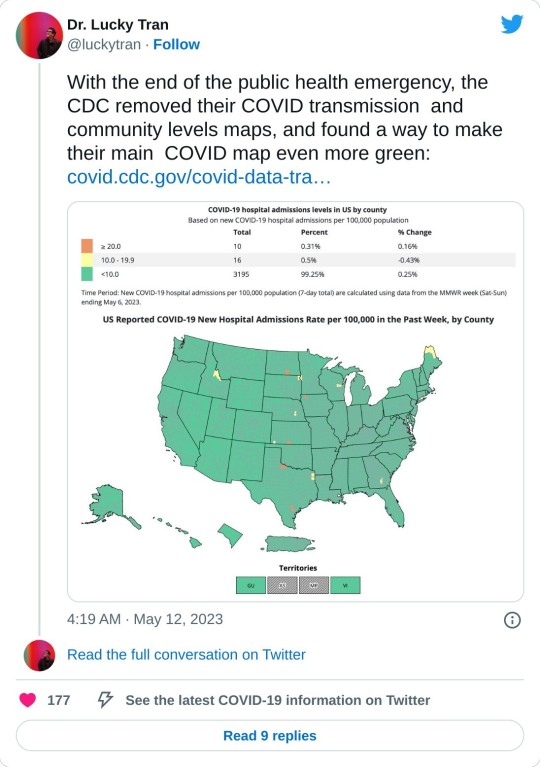
I posted an article awhile back about waste water monitoring finding quite potentially being in a precarious position. Furthermore this would lead to outbreaks and the general public being unawares and run afoul of horrible outcomes.
The work of aggregating and collating of data is being left to individuals, which is not only horrifying, unethical and well out of step with science based methods and guidance, but highly unusual given data is kept and provided for other illnesses, especially ones as severe and concerning as covid-19 (SARs CoV 2).
For the time being, I personally will be assuming transmission is moderate to high in addition to my sources. In the absence or great reduction of data and reports, greater estimations and assessment of made, and when only observations, assumed. Be as safe as you can everyone 💝 - Admin
Please be aware of what may no longer be offered, operating or an out of pocket cost. Masks, tests (all types), vaccines, remote options, COVID-19 tracking apps. Also be mindful of any local or nationwide level policies, proposals, news or trends that cite mask and other NPI removals, bans, stigma or efforts towards criminalization.
For the time being, the following resources remains invaluable:
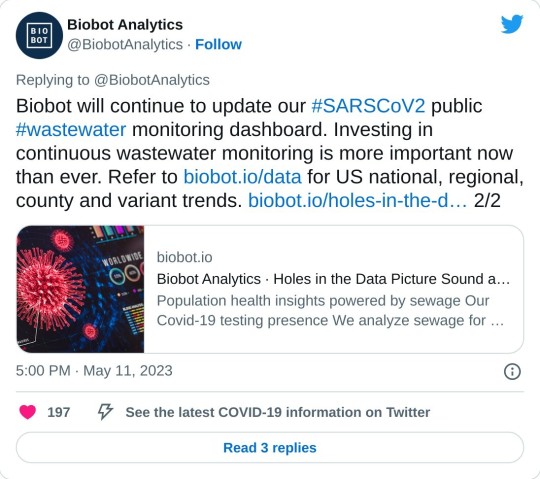
https://biobot.io
It has come to my attention the person whose account is Laughter In Light has falsely claimed a prominent disability advocate encouraged or engaged in doxxing and slander with no demonstrable proof which has led to great harm. Laughter in light has provided some very helpful information throughout the pandemic. It is also important to be aware, critical and hold people into account for their actions, ideologies, commentary/statements and or stances. There are many other wonderful sources to inform oneself and stay up to date. - Admin
Provides regular updates on infectious diseases news
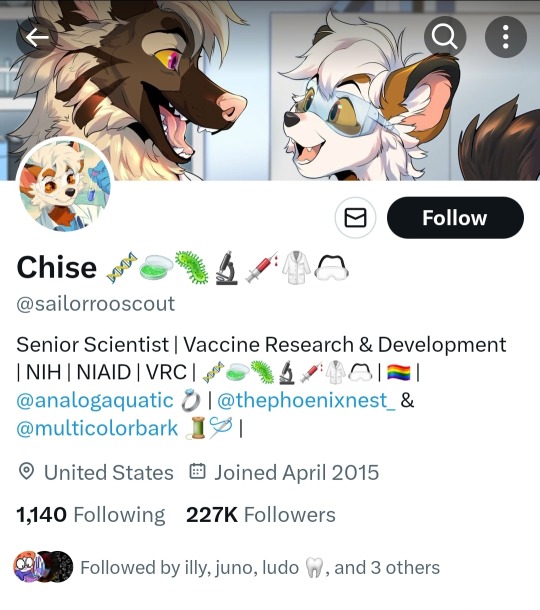
Sadly they don't have a website or any links I know of. Their Twitter is public however and can be viewed even without an account.

Give incredible analysis and updates on SARS CoV-2! Excellent medical and scientific communicator!
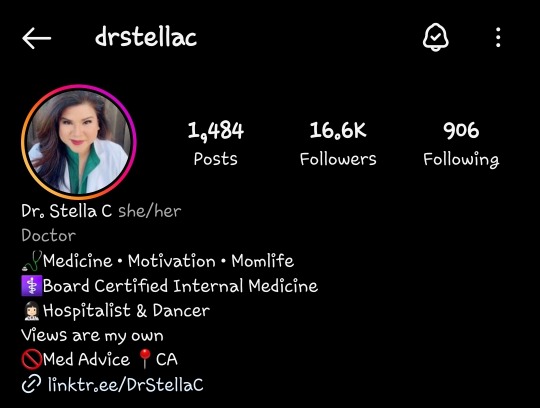
Stella has been amazing since the beginning and continues to be. Definitely worth following! Check out their link tree! They're also on Tiktok!
If anyone has any international resources for updates and tracking, please add it via reblog and I'll definitely share! - Admin
#covid-19#covid 19#sars cov 2#covid#Data tracking#Reports#Waste Water Monitoring#Cases#Deaths#Excess Deaths#Long covid#long haul covid#the pandemic#pandemic#public health#Lucky#Lucky Tran#Peoples CDC#Biobot Analytics#Laughter in Light#Tiffany Najberg#Walgreens Covid-19 Index#Waste Water Scan Dashboard#Our World In Data
20 notes
·
View notes
Text
Is Social Media Useful in Spreading Information on COVID-19 in Malaysia?

In the current digital era, social media has become an integral part of our lives, connecting us to our family, friends, and the world. In addition to sharing photos, social media has played a significant role in disseminating information about crucial issues, particularly during the COVID-19 pandemic. Let's explore how social media helps spread virus-related information and its impact on digital communities.
The Power of Social Media for COVID-19 Information
1. Rapid Dissemination of Information
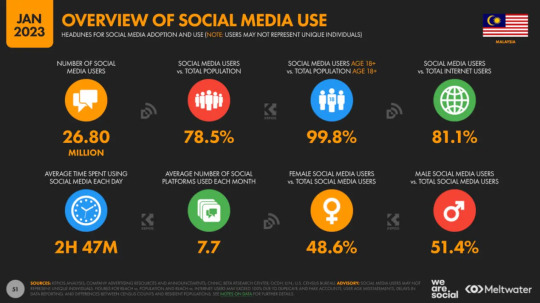
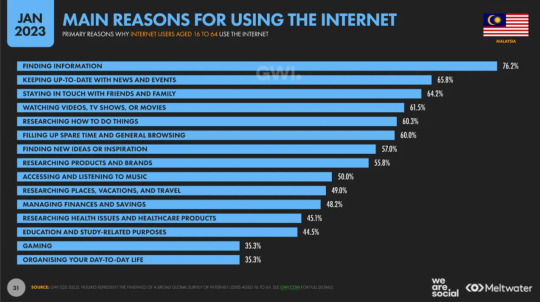
During the early phases of the COVID-19 pandemic, the increased social media activity in Malaysia played a crucial role. Malaysians were well-connected digitally, as they spent an average of 2 hours and 47 minutes daily on social media, surpassing the global average by a significant margin. This participation was primarily motivated by the need to obtain information (76.2%) and keep up with news and events (65.8%). Facebook, Twitter, and WhatsApp were the primary sources for vital updates, news, and recommendations. This ongoing flow of information helps increase the awareness and preparedness of the digital community (Howe, 2023).
2. Real-time Updates
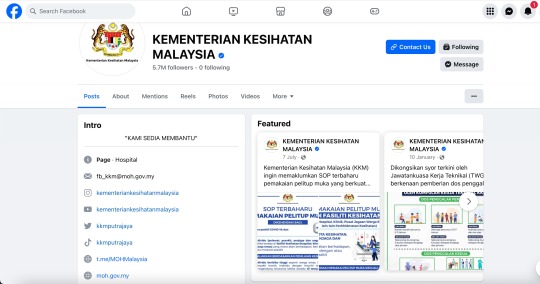

The Malaysian government provided up-to-date COVID-19 information via e-government and social media. They relied on channels such as the Ministry of Health's Official Portal, specialised Facebook pages (such as CRPC and KKM), and the CPRC KKM channel on Telegram. The Director-General of Health's daily press briefings are not only broadcast live on television but also live online via Facebook. In April 2020, they released the MySejahtera mobile app to assist users in monitoring their health and reporting check-in locations, allowing for prompt responses to control the spread of the virus (Dawi et al., 2021).
3. Community Support

During these difficult times, social media has been essential in helping Malaysians feel more connected to one another, with many Facebook groups and online communities offering information and support. For example, neighbours used platforms such as Nextdoor to offer assistance to those in need, and digital communities united in unprecedented ways to share resources and aid one another (FMT Media Sdn Bhd, 2020). Moreover, #benderaputih groups were formed on Facebook to share addresses for assistance and information on local food banks, with Malaysians in need flying white flags outside their residences to indicate distress. The digital community, including neighbours, personalities, and businesses, responded by donating food and other necessities, demonstrating the power of social media to bring communities together in times of crisis (BBC News, 2021).
4. Countering Misinformation
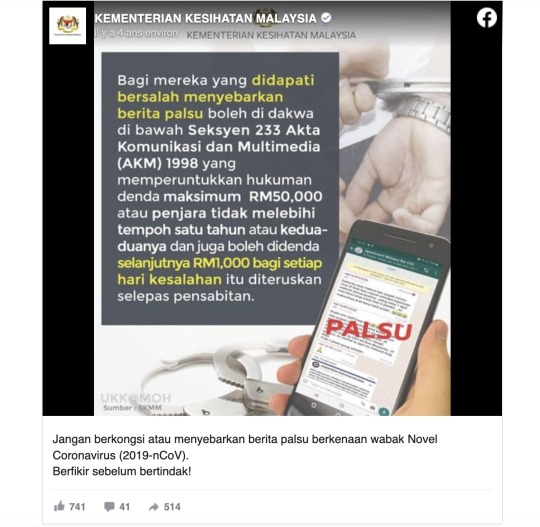
By actively utilizing social media, the Malaysian Ministry of Health (KKM) has taken significant measures to combat COVID-19 misinformation. Through their official social media channels, KKM provides accurate and up-to-date information, dispels misconceptions, and addresses concerns, ensuring that the public receives trustworthy information and is better equipped to make informed decisions during the pandemic. In addition, KKM has released information about the repercussions of disseminating false information. This proactive approach not only helps counter Misinformation but also fosters a sense of trust in official sources, which is crucial during a public health crisis (Euronews, 2020).
The Dark Side of Social Media in COVID-19 Information Spread
1. Misinformation and Rumors
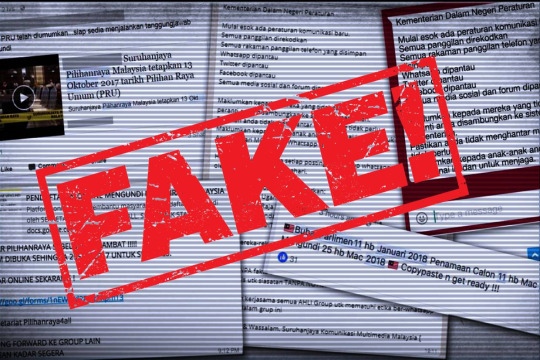
In Malaysia, as in many other countries, social media has served as a breeding ground for Misinformation and rumors about COVID-19. Facebook and WhatsApp have been used to spread false information about the virus's origins, prevention, and treatment options. This has led to public confusion and, in some cases, hazardous behavior, such as disregarding medical advice. False information can undermine the efforts of health authorities and exacerbate the pandemic's effects, causing unnecessary alarm (Balakrishnan et al., 2021).
2. Amplification of Fear

Despite its many advantages, social media can be a double-edged instrument, particularly during a crisis such as the COVID-19 pandemic. One of its negative characteristics is its potential to amplify fear and anxiety. Sensationalized headlines and the dissemination of misleading images can elicit strong emotions, resulting in increased stress and negative effects on mental health. The internet has been rife with misleading information about the virus, including conspiracy theories and misleading statistics. There have been instances where images fraudulently purporting to depict the coronavirus under a microscope have caused panic and confusion. Such false information can be extensively disseminated on social media platforms like Facebook, inciting panic and undermining accurate comprehension (Euronews, 2020).
Conclusion
In conclusion, social media has proven to be a powerful tool in spreading information about COVID-19 in Malaysia. During the pandemic, it rapidly disseminated vital information and connected people, nurturing community and support. The government's use of social media channels contributed to disseminating timely information to the public. However, this has a negative aspect: disseminating false information and terror. Misinformation and sensationalized content have led to public perplexity and hysteria. To maximize the benefits of social media, we must use it responsibly and ensure that accurate information prevails, particularly during the pandemic. Connecting and informing us, social media can be a force for good, but it is up to each of us to ensure that it serves our best interests.
What's your opinion on the role of social media in spreading COVID-19 information in Malaysia? Share your thoughts and vote below.
Reference list
Balakrishnan, V., Ng, K. S., & Rahim, H. A. (2021). To share or not to share – The underlying motives of sharing fake news amidst the COVID-19 pandemic in Malaysia. Technology in Society, 66, 101676. https://doi.org/10.1016/j.techsoc.2021.101676
BBC News. (2021). Malaysians in Covid lockdown fly white flags to ask for help. BBC News. https://www.bbc.com/news/world-asia-57717214
Dawi, N. M., Namazi, H., Hwang, H. J., Ismail, S., Marešová, P., & Krejcar, O. (2021). Attitude toward protective behavior engagement during COVID-19 pandemic in Malaysia: the role of e-government and social media. Frontiers in Public Health, 9. https://doi.org/10.3389/fpubh.2021.609716
Euronews. (2020, January 30). Coronavirus: Malaysia arrests five for spreading misinformation online | #TheCube. Euronews. https://www.euronews.com/my-europe/2020/01/29/coronavirus-malaysia-arrests-five-for-spreading-misinformation-online-thecube
FMT Media Sdn Bhd. (2020). Nextdoor: Free network connecting neighbours in quarantine. Freemalaysiatoday. https://www.freemalaysiatoday.com/category/leisure/2020/03/29/nextdoor-free-network-connecting-neighbours-in-quarantine/
Howe, S. (2023). Social Media statistics for Malaysia [Updated 2023]. Meltwater. https://www.meltwater.com/en/blog/social-media-statistics-malaysia
#mda 20009#week 7#social media#covid19 malaysia#public health#digital communities#malaysia#stayinformed
5 notes
·
View notes
Text
Australia News: 24.3.24.
1.) "The Australian dream of owning your own home - Albanese style. Coming to a city near you."

2.) "Media Shame File: Journalists show their economic illiteracy daily when it comes to immigration, but even so it's worrying that the political editor of The Age doesn't seem to understand how unemployment can fall during record-high population growth."
I'd say they were fully aware of what they were doing.
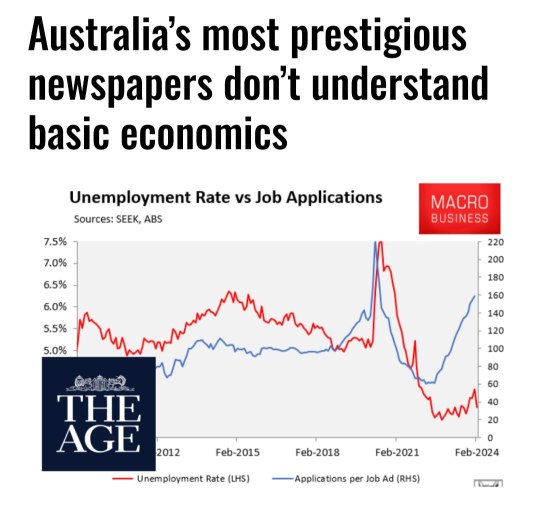
3.) QLD HOMESCHOOLING CRACKDOWN ->
https://youtu.be/TudVFaYc36A
Make a submission: https://qldparlcomm.snapforms.com.au/form/eetsc---education-general-provisions-and-other-legislation-amendment-bill-2024.
It is highly likely that other governments will enact similar harsh laws if they succeed in Queensland. Do not let them.
Also "Our main points of concern:
we do not want to be restricted to using the Australian Curriculum.
reporting to EVERY area in the plan and PROVING educational progress is too much and not even required in schools.
determining if home education is in the best interest of the child is a parental right, this power doesn't belong with the Education department."
Parents should have the freedom to decide how best to educate their children because education is not a one-size-fits-all solution.
4.) NDIS - What is myplace?
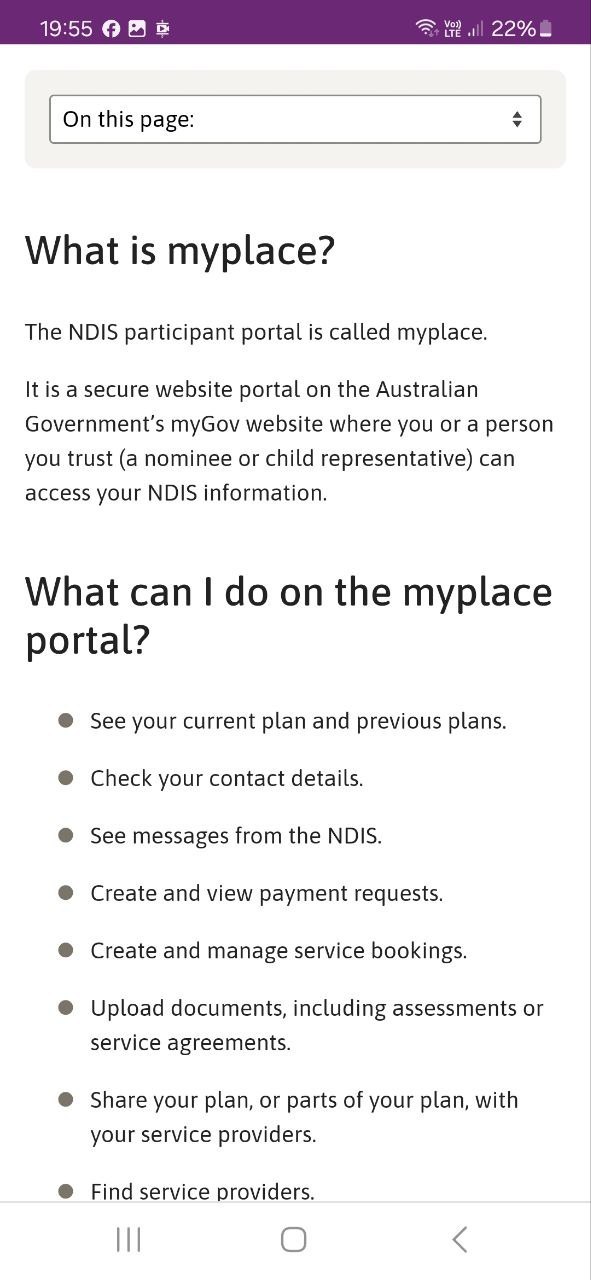
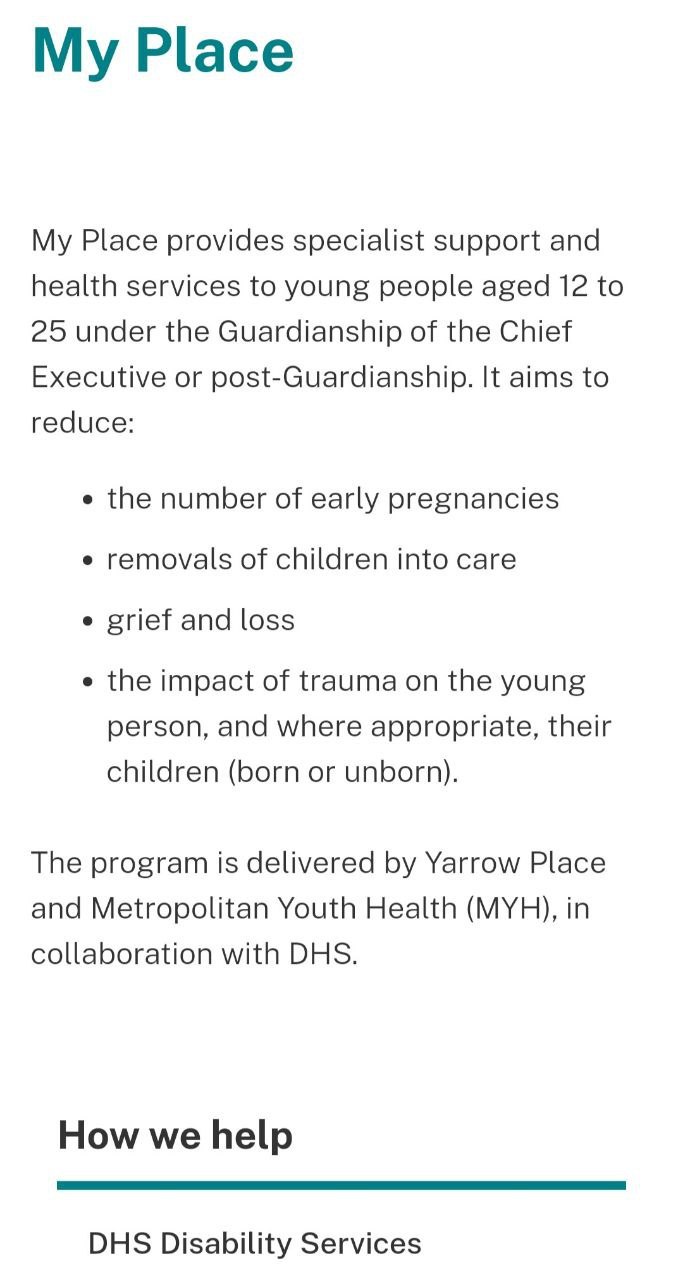
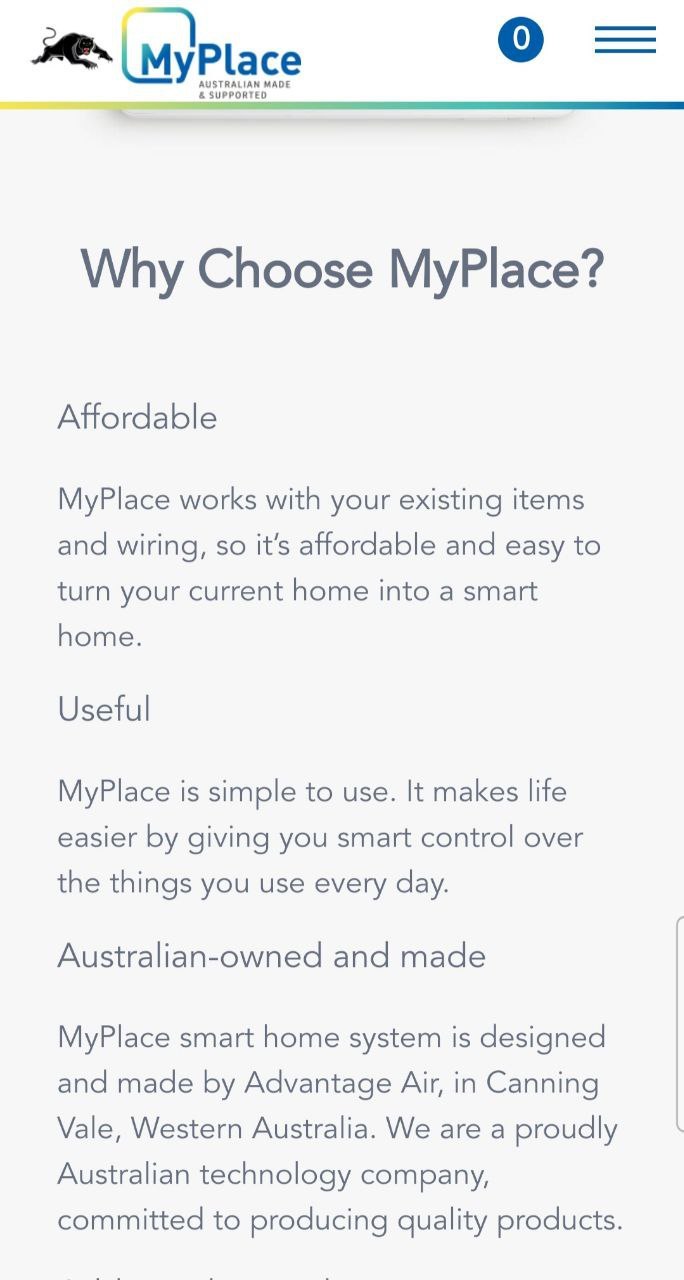
"Just a heads up for all you MyPlace people. There are already trade marked companies in Australia using that name.
Be warned you may be in danger of copyright infringement and court action.
I'm telling you this because I care that you don't get sued, and also because you really should not use someone else's business name. Be original rather than just copying someone else.
The MyPlace brand in Australia is to do with Government, Monitoring, Professional Sports Sponsorship, Public Education and The NDIS. Do you really want your name involved with that?
I wouldn't.
@roobsaussieflyers."
5.) Australia Immigration ->

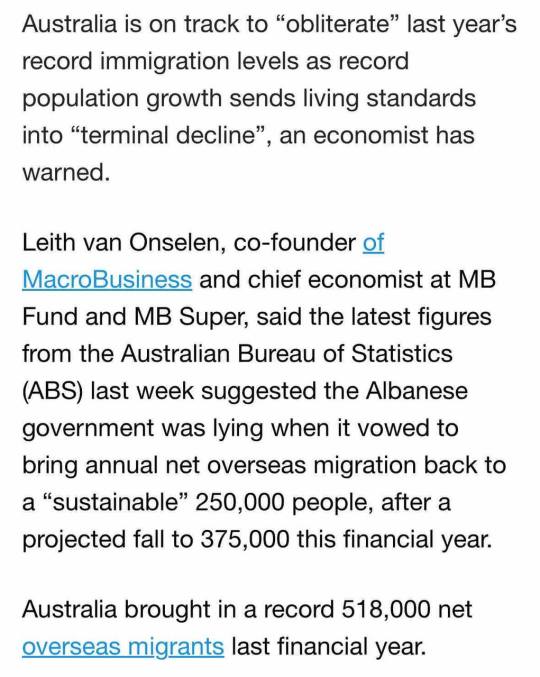
"Record immigration is causing a housing crisis that’s now a human catastrophe
The more serious governance issue is Labor federal government lying last year saying it would reduce immigration
One Nation exposed the Lib-Lab Uniparty “big Australia”
People want immigration cuts." - Senator Roberts uncensored - Telegram.
6.) "Getting a COVID jab is safer than taking aspirin."

"Currently appears on the University of Melbourne website.
“The risk of rare side effects from COVID-19 vaccines like AstraZeneca are greatly exaggerated as they are far safer than many medicines people are taking every day.” "
- @PeoplePowerAus.
2 notes
·
View notes
Text
Spanish climber emerges from cave after 500 days in isolation
AFP | 15 April 2023
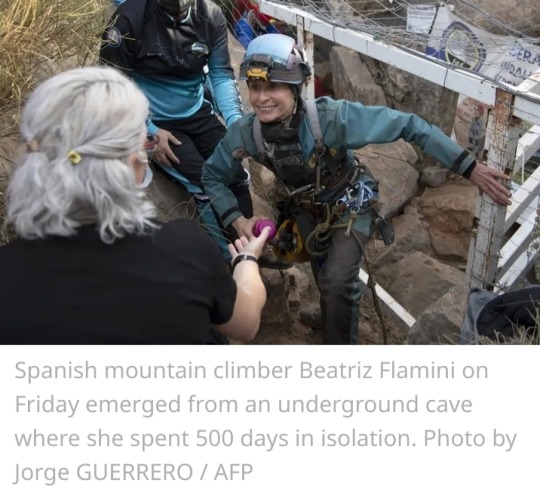
50-year-old climber Beatriz Flamini on Friday evening left an underground cave in Motril, southern Spain, where she spent 500 days in total seclusion as part of an experiment on the effects of isolation on the human body.
Wearing dark sunglasses, Beatriz Flamini smiled and embraced family members who had gathered to greet her as she climbed out of the cave near Motril in southern Spain.
"I haven't talked to anyone for a year and a half, only myself," the experienced mountaineer and solo climber told reporters, calling the experience "excellent, unbeatable."
Flamini began her challenge on 21 November 2021 – before Russia's invasion of Ukraine and while the world was still in the grip of the Covid-19 pandemic.
She remained 70 metres (230 feet) underground, except for a week when she was forced to leave the cave because an internet router that allowed her to call for help in an emergency broke down.
While the problem was being fixed, Flamini remained in isolation in a tent, she and members of her team told daily newspaper El Pais and other Spanish media.
"I don't know what has happened in the world...for me it is still 21 November 2021," she told reporters after leaving the cave.


Flamini said she spent her time reading with the aid of artificial lights, exercising, and knitting woolly hats.
She was monitored by a technical team, who left food at an exchange point in the cave without having contact with her.
Flamini had two cameras to document her experience, which will be turned into a documentary by Spanish production company Dokumalia.
"There have been many challenges of this type, but none with all the rules that were set," said David Reyes of the Andalusian Federation of Speleology, who was in charge of her security.
"Being alone and in total isolation, without contact with the outside, without (natural) light, without time references," he told reporters.
Spanish Tourism Minister Hector Gomez called it an "extreme endurance test," which he hoped would have "great value" for science.
Flamini said one of the toughest moments came when the cave was invaded by flies, but she "never" considered abandoning the challenge.
"There have been difficult moments, and it is true that there have been very beautiful moments, and both are what made it possible to carry one," she said.
"I got along very well with myself," she added.


#Beatriz Flamini#isolation#underground cave#Dokumalia#El Pais#Andalusian Federation of Speleology#Motril#Spain
7 notes
·
View notes
Text
On July 19, Bloomberg News reported what many others have been saying for some time: Twitter (now called X) was losing advertisers, in part because of its lax enforcement against hate speech. Quoted heavily in the story was Callum Hood, the head of research at the Center for Countering Digital Hate (CCDH), a nonprofit that tracks hate speech on social platforms, whose work has highlighted several instances in which Twitter has allowed violent, hateful, or misleading content to remain on the platform.
The next day, X announced it was filing a lawsuit against the nonprofit and the European Climate Foundation, for the alleged misuse of Twitter data leading to the loss of advertising revenue. In the lawsuit, X alleges that the data CCDH used in its research was obtained using the login credentials from the European Climate Foundation, which had an account with the third-party social listening tool Brandwatch. Brandwatch has a license to use Twitter’s data through its API. X alleges that the CCDH was not authorized to access the Twitter/X data. The suit also accuses the CCDH of scraping Twitter’s platform without proper authorization, in violation of the company’s terms of service.
X did not respond to WIRED’s request for comment.
“The Center for Countering Digital Hate’s research shows that hate and disinformation is spreading like wildfire on the platform under Musk’s ownership, and this lawsuit is a direct attempt to silence those efforts,” says Imran Ahmed, CEO of the CCDH.
Experts who spoke to WIRED see the legal action as the latest move by social media platforms to shrink access to their data by researchers and civil society organizations that seek to hold them accountable. “We're talking about access not just for researchers or academics, but it could also potentially be extended to advocates and journalists and even policymakers,” says Liz Woolery, digital policy lead at PEN America, a nonprofit that advocates for free expression. “Without that kind of access, it is really difficult for us to engage in the research necessary to better understand the scope and scale of the problem that we face, of how social media is affecting our daily life, and make it better.”
In 2021, Meta blocked researchers at New York University’s Ad Observatory from collecting data about political ads and Covid-19 misinformation. Last year, the company said it would wind down its monitoring tool CrowdTangle, which has been instrumental in allowing researchers and journalists to monitor Facebook. Both Meta and Twitter are suing Bright Data, an Israeli data collection firm, for scraping their sites. (Meta had previously contracted Bright Data to scrape other sites on its behalf.) Musk announced in March that the company would begin charging $42,000 per month for its API, pricing out the vast majority of researchers and academics who have used it to study issues like disinformation and hate speech in more than 17,000 academic studies.
There are reasons that platforms don’t want researchers and advocates poking around and exposing their failings. For years, advocacy organizations have used examples of violative content on social platforms as a way to pressure advertisers to withdraw their support, forcing companies to address problems or change their policies. Without the underlying research into hate speech, disinformation, and other harmful content on social media, these organizations would have little ability to force companies to change. In 2020, advertisers, including Starbucks, Patagonia, and Honda, left Facebook after the Meta platform was found to have a lax approach to moderating misinformation, particularly posts by former US president Donald Trump, costing the company millions.
As soon as Musk took over Twitter in late October 2022, he proceeded to fire many of the staff members responsible for keeping hate speech and misinformation off the platform and reinstated the accounts of users who had been previously banned, including Trump and influencer Andrew Tate, who is currently indicted under human trafficking laws in Romania. A study released earlier this year from the University of Southern California’s Information Sciences Institute, Oregon State University, UCLA, and UC Merced found that hate speech increased dramatically after Musk took the helm at Twitter. Over roughly the same time period, the company saw its advertising revenue slashed in half as brands—including General Motors, Pfizer, and United Airlines—fled the platform, apparently concerned about their products appearing next to misinformation and hate speech.
And this has bothered Musk, immensely. On November 4, 2022, he tweeted, “Twitter has had a massive drop in revenue, due to activist groups pressuring advertisers, even though nothing has changed with content moderation and we did everything we could to appease the activists. Extremely messed up! They’re trying to destroy free speech in America.”
PEN America’s Woolery worries that, whether or not X’s lawsuit against CCDH holds water, the cost of fighting it will be enough to intimidate other organizations doing similar work. “Lawsuits like this, especially when we are talking about a nonprofit, are definitely seen as an attempt to silence critics,” she says. “If a nonprofit or another individual is not in a financial position where they can really, truly give it all it takes to defend themselves, then they run the risk of either having a poor defense or of simply settling and just trying to get out of it to avoid incurring further costs and reputational damage.”
But the lawsuit doesn’t just put pressure on researchers themselves. It also highlights another avenue through which it now may be more difficult for advocates to access data: third-party social listening platforms. These companies access and analyze data from social platforms to allow their clients—from national security contractors to marketing agencies—to gain insights into their audiences and target messages.
Tal-Or Cohen Montemayor, founder and executive director of CyberWell, a nonprofit that tracks anti-Semitism online in both English and Arabic, says that in November 2022, shortly after Musk took ownership of the company, CyberWell reached out to Talkwalker, a third-party social listening company, to get a subscription that would allow them to analyze anti-Semitic speech on the platform then called Twitter.
Cohen Montemayor says Talkwalker told her the company could not take them on as a client because of the nature of CyberWell’s work. She says it appears that “the existing open source tools and social listening tools are being reserved and paywalled only for advertisers and paid researchers. Nonprofit organizations are actively being blocked from using these resources.”
Talkwalker did not respond to a request for comment about whether its agreements with X prohibit it from taking on organizations doing hate speech monitoring as clients. X did not respond to questions about what parameters it sets for the kinds of customers that third-party social listening companies can take on.
According to X’s lawsuit against CCDH, a 2023 agreement between Brandwatch and X outlined that any breach of X data via Brandwatch’s customers would be considered the responsibility of the social listening company. On X competitor Bluesky, Yoel Roth, the former senior director of trust and safety at Twitter, posted, “Brandwatch’s social listening business is entirely, completely, 100% dependent on Twitter data access, so I guess it’s not surprising to see how far backwards they’re bending to placate the company.”
For its part, in a July 20 tweet, Brandwatch referenced the same CCDH report cited in the X lawsuit, saying, “Recently, we were cited in an article about brand relevance that relied on incomplete and outdated data. It contained metrics used out of context to make unsubstantiated assertions about Twitter.”
Brandwatch did not respond to a request for comment.
But CCDH’s Ahmed says the assertion that his organization’s research is based on incomplete data is a way for X to obfuscate problems with its own platform. “Whenever you claim that you’ve found information on there, they just say, ‘No, it’s a lie. Only we have the data. You couldn't possibly know the truth. Only we know the truth. And we grade our own homework,’” he says.
A representative from another third-party social listening tool that uses X data, who asked to remain anonymous to protect their company from retaliation by X, confirmed to WIRED that companies like theirs are heavily reliant on Twitter/X data. “A lot of the services that are very Twitter-centric, a lot of them are 100 percent Twitter,” they say, noting that Instagram has long since shut down its API, and that conversations on Meta’s platforms tend not to be as public as those on X. “In terms of data, Twitter continues to play a significant role in providing data to analytics companies.” They note that, while X’s new paid-for API has put the squeeze on third-party analytics companies—“it’s basically almost like they’re holding you for ransom”—losing access to X data entirely could kill a company.
They add that they have not seen guidelines that restrict the use of X data for hate speech or advocacy research, but there are specific “know your customer” guidelines that prohibit sharing X data with government agencies without prior permission. The same day X announced the lawsuit, on July 31, America First Legal, a right-wing nonprofit led by former Trump appointee Stephen Miller, announced that it had filed Freedom of Information Act (FOIA) requests to examine communications between CCDH and various US government agencies, alleging that it is a “coordinator of illegal censorship activities.” (Ahmed says his organization has never coordinated with the US government). This would, if true, seemingly also be a violation of those terms of service.
The X lawsuit also alleges that the CCDH is being funded by X’s competitors as well as “government entities and their affiliates,” but says that “X Corp. currently lacks sufficient information to include the identities of these entities, organizations, and persons in this Complaint.”
Even without legal threats, there are significant costs to researchers focused on disinformation and hate speech on platforms. Experts who spoke to WIRED say they worry the threat of legal action could cause a chilling effect on other organizations that study hate speech and disinformation.
After publishing a report showing that anti-Semitic content had doubled on the platform after Musk’s takeover, Sasha Havlicek, cofounder and CEO of the Institute for Strategic Dialogue (ISD), a London-based think tank focused on extremism and disinformation, says the company experienced a deluge of abusive tweets. “In response, Twitter came out with a thread that got 3 million views or so,” she says. “Musk himself responded with a poop emoji.”
In December, Musk worked with right-wing journalists to release the so-called Twitter Files, a selection of internal documents that seemed to show that pre-Musk Twitter had silenced some conservative users. Some of the documents included the names and emails of disinformation researchers at the Stanford Internet Observatory, many of whom were undergraduate students at the time. One former student, who asked to remain anonymous for fear of harassment, says that people whose emails ended up in the Twitter Files have been targets of ongoing harassment for their role in disinformation research.
“Seeing how things have gone, and seeing the possibility of being harassed, has made a lot of people that worked on it very closely to now think twice,” says the former student.
“You have to ask,” says the ISD’s Havlicek. “Who’s the censor now?”
Havlicek says she hopes that the EU’s Digital Services Act (DSA), which will eventually mandate access for researchers to data from large social platforms, will be a road map for other countries. Whether there will be legal land mines regarding data pulled legally by European researchers under the DSA but shared with non-European researchers or advocates is another open question.
“I was in Brussels a few weeks ago talking to the Digital Services people about how we can use the data that will be made available through the DSA data transparency regime,” says Ahmed. “And when that appears, we will use that in the most effective way possible.”
3 notes
·
View notes
Text
Also preserved in our archive (Daily updates!)
At least the tool we kinda have is accurate...
Wastewater surveillance has gained attention as an effective method for monitoring regional infection trends. In July 2024, the National Action Plan for Novel Influenza, etc. included the regular implementation of wastewater surveillance during normal times, with results to be published periodically in Japan. However, when viral concentrations in wastewater are measured inadequately or show significant variability, the correlation with actual infection trends may weaken. This study identified the necessary methods for accurately monitoring COVID-19 infection patterns.
The research team analyzed wastewater data obtained from the city of Sapporo in northern Japan between April 2021 and September 2023. The dataset featured high sensitivity (100 times greater than the standard method) and high reproducibility (standard deviation below 0.4 at log10 values) and was supported by a substantial sample size of 15 samples per week, totaling 1,830 samples over a sufficient survey period of two and a half years. The correlation coefficient between the number of infected individuals and the viral concentration in the wastewater was 0.87, indicating that this method effectively tracks regional infection trends. Additionally, the research team concluded desirable survey frequency requires at least three samples, preferably five samples, per week.
The study provides detailed guidance on wastewater surveillance methodologies for understanding infection trends, focusing on data processing, analytical sensitivity, and survey frequency. As wastewater surveillance during normal times becomes more widely implemented and its results increasingly published, this study's findings are expected to serve as valuable resources for decision making.
Source: Osaka University
Journal reference: Murakami, M., et al. (2024) Evaluating survey techniques in wastewater-based epidemiology for accurate COVID-19 incidence estimation. The Science of the Total Environment. doi.org/10.1016/j.scitotenv.2024.176702. www.sciencedirect.com/science/article/pii/S0048969724068591?via%3Dihub
#mask up#covid#pandemic#wear a mask#public health#wear a respirator#covid 19#still coviding#coronavirus#sars cov 2
44 notes
·
View notes
Text
Lula government ends daily COVID-19 tracking in Brazil
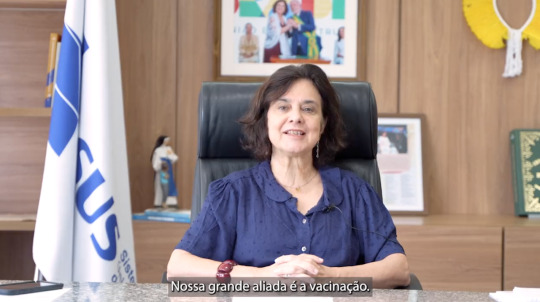
Facing the clear threat of a worsening pandemic in Brazil, driven by the Omicron XBB.1.5 subvariant, the Workers Party (PT) government of President Luiz Inácio Lula da Silva has signaled its intention to declare the pandemic over and get the Brazilian population used to “living” with the coronavirus.
On February 16, the Health Ministry announced that it will start releasing COVID-19 data of cases, deaths and vaccination rates weekly and no longer daily, starting March 3. Trying to justify what in practice means a further departure from monitoring the pandemic in the country, the Health Ministry’s director of immunization, Eder Gatti, stated that only nine of the 27 Brazilian states update the data daily, which supposedly does not “allow an epidemiological analysis.” Still, he claimed,“We are not restricting data. ... What we want here is to facilitate the work with the data and send weekly data that is more accurate.”
This claim is patently false. If the Lula government had a genuine concern about the pandemic, the least it could do is coordinate a national effort and assist the states in implementing a system to monitor the pandemic on a daily basis, with a mass testing program, genetic sequencing of the variants in circulation, among other measures completely ignored by the “herd immunity” policy of the former fascistic President Jair Bolsonaro.
However, almost two months after taking office, the Lula government has not reversed the Bolsonaro government’s measures to prioritize corporate interests over human lives, including its ending of the National Public Health Emergency due to COVID-19 as early as April 2022. The Lula government has also failed to implement awareness campaigns about the airborne transmission of SARS-CoV-2, the importance of wearing quality masks and distributing them for free, as well as other basic public health measures that would have an almost immediate impact and could prevent cases and deaths.
Continue reading.
#brazil#politics#brazilian politics#coronavirus#covid 19#nisia trindade#mod nise da silveira#image description in alt
37 notes
·
View notes
Text
Attention companies…….Time to up your risk management game
Effective risk management systems are crucial for companies, irrespective of their size and sector/ industry. These alone can help mitigate potential losses and protect the company from the adverse impact of unexpected events. Risk management involves identifying, assessing, and prioritizing risks, and implementing strategies to mitigate them.

Risks are a daily occurrence in most businesses. Hence it very crucial to put in place systems to control or mitigate them effectively. Risks, if not identified and dealt with at the right time, could turn into unanticipated major incidents, which may result in losses or damage the reputation of the company.
Many companies have a narrow and rigid approach to risk management. This usually does not account for the complexities of the business. COVID-19 pandemic was one such rare occurrence which caught almost all companies off-guard. How quickly some companies were able to identify the risks, and attempt to mitigate them, showed how good the risk management frameworks of such companies were. For others, this exposed the company to various risks, not limited to financial, operational, legal or business risks.
Risk Management is crucial for the companies for the following reasons:
Ensuring continuity of operations: Effective risk management helps in ensuring that critical business processes and operations are not interrupted by unexpected events.
Enhancing decision making: Effective risk management provides a better understanding of potential risks and their impact. Risk management helps the decision-makers take more informed decisions.
Minimizing Loss: Risk management helps in identifying potential risks and developing strategies in advance to mitigate or eliminate them. This helps in reducing the severity of losses.
Improving financial stability: Risk management can help organizations avoid financial losses and maintain stability, which is crucial for long-term success.
Protecting reputation and increasing stakeholder confidence: Reputation is an integral part of any organization. Managing risks effectively at the appropriate time can help protect an organization’s reputation and maintain stakeholder trust with investors, customers, and regulators.
Complying with legal and regulatory requirements: Compliance with legal and regulatory requirements is crucial for avoiding penalties and ensuring that companies operate in an ethical and responsible manner.
It is important for companies to have an effective risk management framework to up their risk management game. Some steps that companies can undertake are:
Setting up a Risk Management Committee (RMC): The RMC is a Board-level committee consisting of members of Board and senior management, and tasked with developing and implementing a risk management framework. The committee is also responsible for monitoring and reporting on the effectiveness of risk management strategies and ensuring that appropriate controls are in place to manage risks.
Establishing an effective risk management framework: The framework, as developed by the RMC, should cover all areas of the business, including operational, financial, legal, and strategic risks, and should involve regular risk assessments and audits, the development of risk mitigation strategies, and continuous monitoring and reporting of risks.
Developing an all-inclusive risk management plan: Companies should formulate a detailed plan outlining their approach towards risk management, including identification of risks, assessment of their impact, and the implementation of strategies to manage the risks.
Establishing a risk appetite: A company’s risk appetite refers to the level of risk that the company is willing to accept. Being cautious can help a company avoid losses, but it can also lead to missed opportunities for growth and innovation. On the other hand, taking excessive risks could harm the company’s reputation, financial performance, and overall sustainability. Therefore, it is crucial for companies to strike a balance between taking risks and managing them effectively.
Maintaining a risk register: Maintaining a risk register and updating it periodically are essentials for effective risk management. A well-maintained risk register can provide valuable insights that enable companies to better understand their overall risk exposure and make informed decisions about how to manage risks proactively.
Classifying risks based on likelihood and impact: Likelihood refers to the probability of a risk event occurring, while impact refers to the severity of the event if it were to occur. This approach helps shall help in prioritising risks based on the probability of occurrence and the potential impact.
Appointing a Chief Risk Officer (CRO): The CRO is responsible for overseeing the development and implementation of risk management strategies. The CRO works closely with other senior executives to ensure that risks are identified and managed appropriately.
Identifying a process owner for mitigation of every identified risk: There should be a process owner who should be held accountable for his/her efforts for mitigating risks.
Engaging in continuous risk assessment: Risk management is an ongoing and a continuous process that requires companies to assess the risks on a regular basis and form a strategy and action plan accordingly. Companies should undertake continuous assessment of risks to identify new risks, if any.
Engaging with internal audit team: A good internal audit function and risk management function go hand in hand in identifying and mitigating risks.
Investing in risk management tools and technologies: Technology can be a powerful tool for managing risk. Artificial intelligence, and data analytics are helping organizations go beyond the old ways of managing risks, by using technology to detect, predict, and prevent risks in high-risk situations. Companies should invest in risk management software and other technologies that can help them identify and manage risks more efficiently.
Convening RMC meetings regularly: Having RMC meetings at regular intervals helps in reviewing the status of the company’s risk management plan, identifying emerging risks, evaluating existing risks, and developing risk mitigation strategies. While Regulations do not mandate a quarterly meeting of the RMC, it is a good idea for companies to have meetings every quarter.
Prioritizing employee training and education: Companies should prioritize employee training and education on risk management. Employees should be educated on the risks facing the company, the strategies to mitigate them, and their roles and responsibilities in implementing the strategies.
Fostering a culture of risk awareness: Risk management should be deep-rooted in the company’s culture. Companies should encourage employees to speak up if they identify potential risks thereby promoting a culture of continuous improvement in risk management practices.
Effective risk management requires a proactive and systematic approach that involves all levels of the organization. By prioritizing risk management and implementing best practices, companies can better protect themselves and their stakeholders from potential risks and uncertainties.
Source:https://excellenceenablers.com/attention-companies-time-to-up-your-risk-management-game/
#RiskManagement#BusinessContinuity#CorporateGovernance#RiskMitigation#StrategicPlanning#BoardLeadership
0 notes
Text
Open Your Career: Discover Free CNA Classes in Massachusetts for 2023!
Unlock Your Career: Discover Free CNA Classes in Massachusetts for 2023!
in today’s competitive job market, finding a career that provides both stability and personal fulfillment is essential. One such opportunity is in the healthcare field as a certified Nursing Assistant (CNA).In Massachusetts, there are several avenues to receive free CNA classes in 2023, allowing you to kick-start your career without worrying about tuition costs. This thorough guide will help you navigate the options available, the benefits of becoming a CNA, practical tips, and firsthand experiences.
What is a CNA?
A Certified Nursing Assistant (CNA) plays a crucial role in patient care. Responsibilities typically include:
Assisting patients with daily activities such as bathing, dressing, and eating.
Monitoring patient health by checking vital signs.
Providing emotional support to patients and their families.
Communicating patient needs to registered nurses (RNs) and other healthcare staff.
With an increasing demand for healthcare services, becoming a CNA offers a promising career path.
Benefits of Taking Free CNA Classes
opting for free CNA classes can have multiple benefits, including:
No Financial Burden: Eliminate tuition costs as you pursue your education.
Quick Employment Opportunities: CNAs are in high demand across healthcare facilities, ensuring a quick entry into the job market.
Hands-On Training: Gain practical skills that prepare you for real-life situations in patient care.
Flexible Schedules: Many programs offer evening or weekend classes, allowing you to balance work and education.
Where to find Free CNA Classes in Massachusetts
Several institutions and organizations in Massachusetts provide free CNA training classes. Here’s a table summarizing the most notable options:
Institution/Association
Location
contact
JobCorps
Various locations
1-800-733-5627
american Red Cross
Boston, MA
1-800-RED-CROSS
Community Colleges
throughout Massachusetts
Check local listings
Massachusetts Workforce Development
Statewide
1-617-626-7100
Practical Tips for Navigating CNA Classes
Enrolling in a CNA program is just the beginning. Here are valuable tips to ensure your success:
Research Courses: Look for accredited programs that meet state requirements.
Prepare for the Exam: Familiarize yourself with the Massachusetts CNA exam format and content.
Engage with Instructors: Don’t hesitate to ask questions and seek additional help when needed.
Network: Build connections with classmates and instructors for potential job leads and mentorship.
First-Hand Experiences: What to expect in a CNA Program
To understand the real-life implications of becoming a CNA, we interviewed several recent graduates of Massachusetts CNA programs:
“The hands-on training was invaluable. I learned not just the skills, but also how to connect with patients on a personal level.It’s a tough job,but incredibly rewarding!” — Sarah,CNA Graduate.
“Initially, I was worried about the exams, but the support from instructors made a huge difference. They really believed in us!” — Michael, CNA Graduate.
Case Studies: Prosperous CNA Career Paths
Here are two examples of individuals who successfully transitioned into their CNA careers:
Maria’s Journey
Maria was a stay-at-home mom who decided to return to work. She enrolled in a free CNA program at a local community college. After graduating, she secured a position in a nursing home, quickly working her way up to a supervisory role.
James’ Path
james faced unemployment due to the COVID-19 pandemic. He found a free CNA class offered by JobCorps. Upon completion, he landed a job at a hospital, where he continues to develop his career in nursing.
Conclusion
The pathway to becoming a Certified Nursing Assistant in Massachusetts is both accessible and fulfilling. With the availability of free CNA classes in 2023, there has never been a better time to enhance your career prospects in healthcare. By taking advantage of these programs, you can gain essential skills while making a notable impact on patients’ lives. Start your journey today by exploring the options available and unlock your career as a CNA!
youtube
https://coursescna.com/open-your-career-discover-free-cna-classes-in-massachusetts-for-2023/
0 notes
Text
How Increased Surveillance by the China Government during the Global COVID-19 Pandemic Affects Online Communities?

In the wake of the global COVID-19 pandemic, governments worldwide, including China, intensified surveillance measures to curb the virus's spread. In this context, China's implementation of stringent surveillance, notably through Health Code Apps, has raised profound concerns about its impact on online communities. As facial recognition and data collection become intrinsic to daily life, the potential repercussions on digital spaces and the people within them demand careful examination. This discussion delves into the multifaceted consequences of increased surveillance by the Chinese government and its tangible effects on the dynamics of online communities.
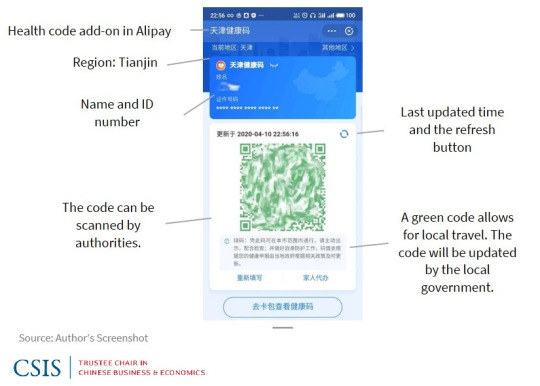

Privacy Erosion
In response to the global COVID-19 pandemic, various countries implemented measures to track and control the virus's spread, introducing tools such as contact tracing apps (Ojokoh et al., 2022), temperature checks (Qu & Lv, 2021) and travel restrictions (Burns et al., 2021). Simultaneously, In China, where stringent surveillance measures were already in place, the government leveraged technology to an even greater extent, using facial recognition and health QR codes to monitor citizens' movements. This involved the deployment of a series of applications known as "Health Code Apps," which have raised concerns about privacy erosion, particularly regarding the use of health code applications. Online communities are not immune to this erosion, as the data collected through these apps includes personal information, health status, and location details. This data is then utilized to assign one of three colours, indicating the user's health status (Ramos, 2020). However, Data is funnelled to entities like the provincial Big Data Bureau, Alibaba, and the telecommunications department, expanding the accessibility to user information, ranging from personal details to health status, location, and device specifics. This centralized model amplifies the risks of data aggregation and user re-identification, exemplified by the Beijing Health Bao system's data leak in December 2020. The incident exposed the photographs, ID numbers, and nucleic acid test information of celebrities, highlighting insufficient safeguards in place (Zhang, 2022). Online communities may find their members exposed to privacy breaches, leading to a chilling effect on open communication and expression within these digital spaces.

Potential for Abuse of Power:
The potential for the abuse of power in the context of surveillance, inadequate transparency and compliance measures is a significant concern for online communities as well. This concern is exemplified by recent events in Henan Province, where health code apps were allegedly manipulated to suppress protests related to potential losses in rural banks on the brink of collapse (Zhang, 2022). The legitimacy of these health code apps faced a setback as city officials marked over a thousand individuals as red, restricting their entry into Zhengzhou City and highlighting the vulnerability of such systems to misuse (Zhang, 2022). This incident underscores the potential for health code apps, initially designed for public health purposes, to transform into tools of surveillance, allowing government agencies to exert control under the guise of maintaining public health. The lack of stringent transparency requirements heightens the risk of these technologies being misused for purposes beyond their intended scope, which negatively impacts the freedom of expression within online communities. As governments exploit surveillance tools to monitor and influence online discussions, online communities may face challenges related to censorship and control, further emphasising the interconnected nature of surveillance concerns and their impact on digital spaces.
Technological Dependence:
Embracing extensive surveillance often involves a reliance on advanced technologies. In the case of Health Code Apps, facial recognition technology is integrated into residential area access control systems, permitting entry only to those with a green code (Ramos, 2020), which has implications for online communities. This reliance on advanced technologies may neglect more human-centric approaches to online interaction, potentially excluding or disadvantaging certain members of digital communities. As surveillance technologies become integral to online platforms, the balance between security measures and preserving the inclusivity and diversity of online communities becomes a critical consideration.
Trust Deficit:
The colour-coded system assigned by health code applications has far-reaching consequences for millions of users in their interactions within both physical and online communities. Requiring individuals to display their health codes in public transportation, shopping malls, markets, and other public places may contribute to a trust deficit between citizens and the online platforms they engage with (Jao et al., 2020). Users within online communities may question the motives behind such surveillance measures, especially if their personal information is shared without their knowledge. Rebuilding trust within online communities, once eroded by mandatory health code reliance, poses a considerable challenge, impacting the dynamics of digital social spaces.
In conclusion, the surge in surveillance by the Chinese government amid the global COVID-19 pandemic undeniably leaves a lasting imprint on online communities. The colour-coded system mandated by health code applications not only infiltrates public spaces but also infiltrates the very essence of digital interactions. This imposition triggers a tangible trust deficit within online communities as individuals question the motives behind these surveillance measures. Rebuilding trust within these virtual spaces, essential for vibrant and open communication, becomes a formidable challenge in the aftermath of mandatory health code reliance. The delicate equilibrium between bolstering security measures and safeguarding the inclusivity of online communities emerges as the linchpin for preserving the dynamic and diverse nature of these digital spaces. In essence, the impact of increased surveillance by the Chinese government is intimately intertwined with the well-being and resilience of online communities.
"Considering the implications of increased surveillance by the Chinese government during the global COVID-19 pandemic on online communities, we'd like to hear your perspective. How do you perceive the effects on privacy erosion, potential abuse of power, technological dependence, and the trust deficit within these digital spaces? Share your insights and cast your vote below."
Reference List
Burns, J., Movsisyan, A., Stratil, J. M., Biallas, R. L., Coenen, M., Emmert-Fees, K., Geffert, K., Hoffmann, S., Horstick, O., Laxy, M., Klinger, C., Kratzer, S., Litwin, T., Norris, S. L., Pfadenhauer, L. M., Von Philipsborn, P., Sell, K., Stadelmaier, J., Verboom, B., . . . Rehfuess, E. (2021). International travel-related control measures to contain the COVID-19 pandemic: a rapid review. The Cochrane Library, 2021(3). https://doi.org/10.1002/14651858.cd013717.pub2
Jao, N., Cohen, D., & Udemans, C. (2020). How China is using QR code apps to contain Covid-19. TechNode. https://technode.com/2020/02/25/how-china-is-using-qr-code-apps-to-contain-covid-19/
Ojokoh, B. A., Aribisala, B. S., Sarumi, O. A., Gabriel, A. J., Omisore, O. M., Taiwo, A. E., Igbe, T., Chukwuocha, U. M., Yusuf, T. A., Afolayan, A., Babalola, O., Adebayo, T., & Afolabi, O. (2022). Contact Tracing Strategies for COVID-19 Prevention and Containment: A scoping review. Big Data and Cognitive Computing, 6(4), 111. https://doi.org/10.3390/bdcc6040111
Qu, J., & Lv, X. (2021). The response measures to the coronavirus disease 2019 outbreak in China. Open Forum Infectious Diseases, 8(2). https://doi.org/10.1093/ofid/ofab014
Ramos, L. F. (2020). Evaluating privacy during the COVID-19 public health emergency. The ACM Digital Library, 176–179. https://doi.org/10.1145/3428502.3428526
Zhang, X. (2022). Decoding China’s COVID-19 health code apps: the legal challenges. Healthcare, 10(8), 1479. https://doi.org/10.3390/healthcare10081479
4 notes
·
View notes